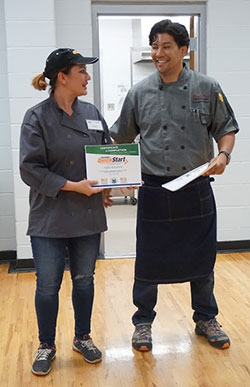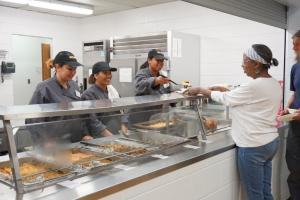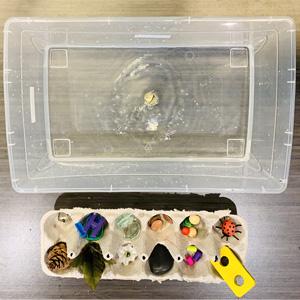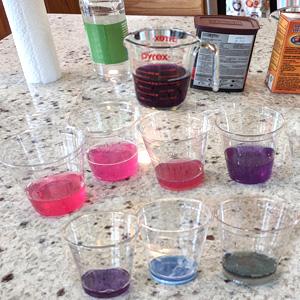Categories
Sufia immigrated to the United States after meeting her husband, Joshua Davidson. He is a soldier at Fort Carson and met Sufia in her home country of Afghanistan. The two were married in 2009 and in the first six years of their marriage had two beautiful children.
Sufia loved her new home and life but was still missing one thing she really wanted: a job. While attending GED test preparation classes at Pikes Peak Library District (PPLD), she was visited by Lacey Miller, PPLD’s Library Instruction Designer. Lacey told Sufia’s class about a new training opportunity: Food Industry Training. The certification program prepares participants in an intensive four week format to become qualified line and prep cooks.
“Miss Lacey told us that with this class you could learn lots of skills and you could find a job in the restaurant industry,” Sufia said. “I wasn’t sure I could do this, but then I talked to my husband. He told me to go do it because in my home country, I wouldn’t have an opportunity like this because I am a woman.”
Sufia enrolled in the program and began her intensive training during May 2019. Now, she’s a Food Industry Training graduate and working in a prominent Colorado Springs hotel.
 The Food Industry Training program is recognized by the Pikes Peak Workforce Center and several other workforce centers in Colorado as an approved training option. Students learn the foundational skills necessary in the food service industry, such as: kitchen safety, knife skills, basic math, recipe reading, and cooking methods. Food safety and sanitation are part of every class. Real world life skills, including dependability, adaptability, memorization, time management, and team work are also of great emphasis. Work readiness skills like resume preparation, job search, and interview practice and preparation are included, too. Food Industry Training graduates have been hired by The Broadmoor, The Mining Exchange Hotel, UC Health hospitals, senior living centers, and others.
The Food Industry Training program is recognized by the Pikes Peak Workforce Center and several other workforce centers in Colorado as an approved training option. Students learn the foundational skills necessary in the food service industry, such as: kitchen safety, knife skills, basic math, recipe reading, and cooking methods. Food safety and sanitation are part of every class. Real world life skills, including dependability, adaptability, memorization, time management, and team work are also of great emphasis. Work readiness skills like resume preparation, job search, and interview practice and preparation are included, too. Food Industry Training graduates have been hired by The Broadmoor, The Mining Exchange Hotel, UC Health hospitals, senior living centers, and others.
In the past, the Food Industry Training program has generously been hosted in kitchens at other organizations throughout the city. But, without a deep freezer, gas line, and necessary appliances, students have been unable to experience the full scope of working in a commercial kitchen and our program offerings have been limited to times when kitchen space was made available to us. This year, and with your support, PPLD is bringing this program in house with the renovation of kitchen space at Library 21C. Turning this space into a state of the art kitchen will help us grow and improve the Food Industry Training program and create new food education programs for our patrons. These programs, when we have been able to offer them, have been wildly popular!
In the time of COVID 19, when millions of Americans are experiencing joblessness and uncertainty, PPLD is proud to offer programs that will help members of our community get back to work. The Food Industry Training program helps not only individuals like Sufia, but area restaurants and businesses that are hurting in the aftermath of this public health crisis.
Will you support PPLD, and programs like Food Industry Training, by donating today? We serve you, your family, friends, and neighbors and exist to provide resources and opportunities that impact individual lives and build community.
Supplies:
- A container filled with water
- Various objects of different sizes and weights - examples: beads, rocks, pennies, small plastic toys
Directions:
- Drop in objects and observe the effect on the water
- Discuss what you see. Do you notice a ripple? Does it make a splash? What happens if you drop in lots of objects at once?
- Discuss how our behavior and actions also have an effect on the world around us.
- Make a list of acts of kindness you can do.
- Spread the ripple effect of kindness!
Watch this project at: https://www.youtube.com/watch?v=zHM_X3wcmfQ&list=PLMEg2Dd0dSFctLfDQxsL5…
Supplies:
- 2-3 purple cabbage leaves
- 4 cups water
- Blender
- Strainer
- Bowl
- Paper towel
- Several clear containers or cups
- Vinegar
- Baking soda
- Optional: liquid dishwasher detergent, fruit juice, clear soda or carbonated water, soap, salt, other kitchen substances (with grownup approval)
Directions:
- Tear 2 to 3 leaves off the head of a purple cabbage, tear leaves into smaller pieces.
- Put cabbage leaves into a blender with about 4 cups of water and with a grownup's help, blend on high until the liquid is very purple with a few chunks remaining.
- Strain cabbage juice into mesh strainer lined with paper towel, over a large bowl.
- Pour the cabbage juice into a container or pitcher. This purple cabbage juice is now your pH indicator.
Purple cabbage juice contains a compound called anthocyanin. Anthocyanin will turn pink when mixed with acid, blue-green when mixed with a base, and purple when mixed with a neutral substance, such as water. - Take 3-4 additional clear containers: add a spoonful of baking soda to one cup; add a few spoonfuls of vinegar to a second cup; add a bit of water to a third cup.
- Ask your grownup if you can use a small amount of dishwasher detergent into an additional cup.
- Now, you'll add some cabbage juice to each of the four cups you've prepared, even the one that's just water. When the purple cabbage juice is mixed with vinegar, what happens? (You should see the mixture turn pink.) Why? Vinegar is an acid. Pour cabbage juice into the container with baking soda, then also the cup with the dishwasher soap. What is happening to these two solutions? (Baking soda is a base, so it will turn bluish-purple. The dishwasher soap mixture should turn a vivid blue-green because dishwasher soap is very basic, or alkaline.) What happened when you added cabbage juice to just water?
- Line your four cups up on the counter. You will use these color results to compare other substances you want to test to see if they are acids or bases.
- Pink indicates an acid. Place this cup to the left. Purple (water) is neutral. Place this one in the middle. Blue-green is basic. Place this cup to the right of the purple cup. If you used dishwasher detergent, place this cup to the very far right. It’s one of the most alkaline substances you will find in a kitchen.
- Now, try adding purple cabbage juice to other substances you want to test.
- Compare the colors of your test mixtures and place them between the cups, where you think they should go. Soon, you will have a spectrum of acids and bases and you can compare the acidity of two substances, such as vinegar vs. orange juice.
Watch this project at: https://www.youtube.com/watch?v=7nB1UzYZf4s&list=PLMEg2Dd0dSFctLfDQxsL5…





